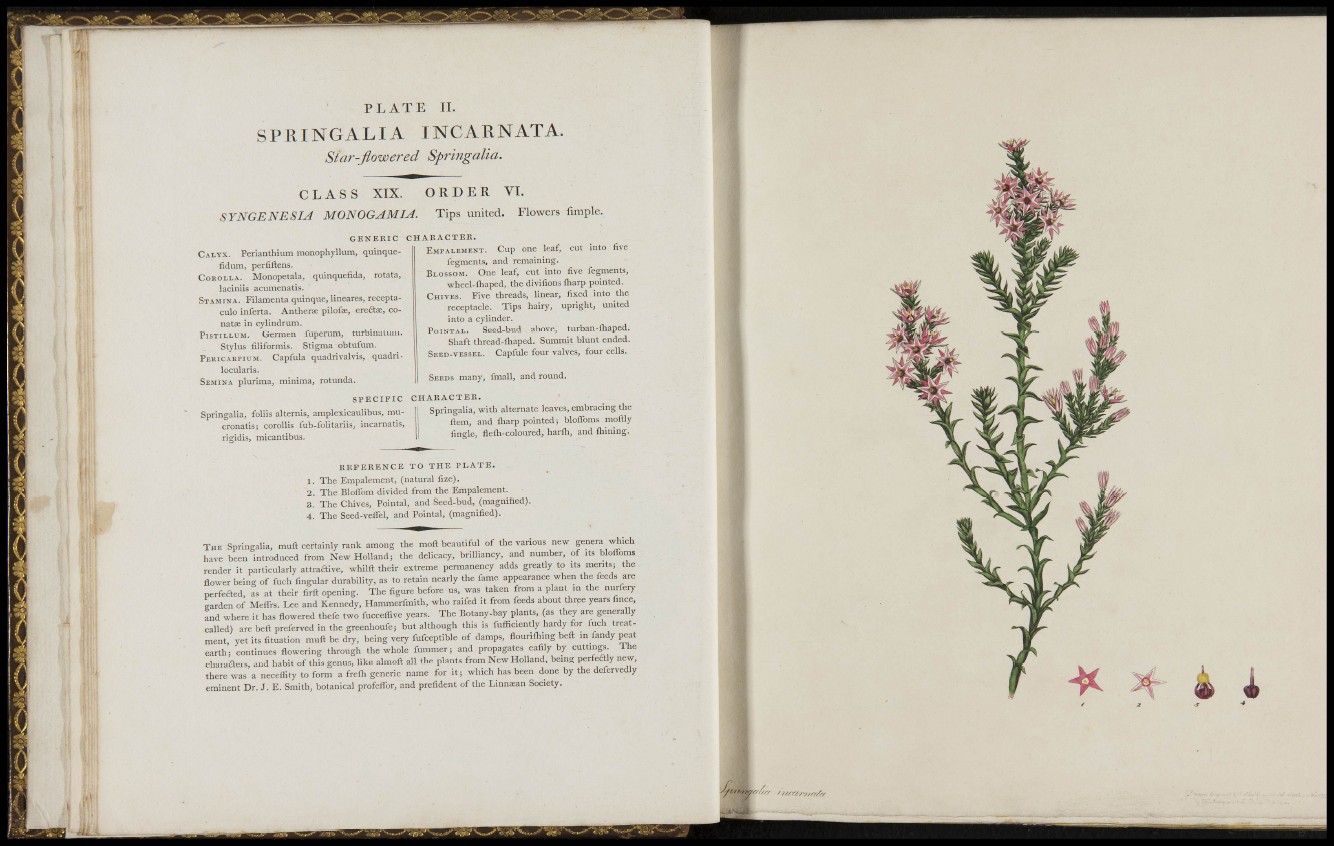
P L A T E II.
SPRINGALIA INCARNATA.
Star-flowered Springalia.
C L A S S XIX. ORDER VL
SYNGENESIJ MONOGAMU. Tips united. Flowers fimple.
G E N E R I C
C A L Y X . Periantliium monophyllum, quinquefidum,
perfiftens.
C O R O L L A . Monopetala, quinquefida, rotata,
laciniis acumenatis.
S T A M I N A . Filamenta quinqué, lineares, receptaculo
inferta. Antherse pilofae, ere6tEe, conatae
in cyllndrum.
PisTiLLUM. Germen fuperum, turbinatum.
Stylus filiformis. Stigma obtufum.
P E R I G A K P I U M . Capfula quadrivalvis, quadrilocularis.
S E M I N A plurima, minima, rotunda.
S P E C I F I C
Springalia, foliis alternis, amplexicaulibus, mucronatis;
corollls fub-folitariis, incarnatis,
rigidis, micantibus.
C H A R A C T E R .
E M P A L E M E N T . Cup one leaf, cut into five
fegments, and remaining.
B L O S S O M . One leaf, cut into five fegments,
wheel-fliaped, the divifions iharp pointed.
C H I V E S . Five threads, linear, fixed into the
receptacle. Tips hairy, upright, united
into a cylinder.
P o i N T A L . Seed-bud above, turban-iliaped.
Shaft thread-lliaped. Summit blunt ended.
S E E D - V E S S E L . Capfule four valves, four cells.
SEEDS many, fmall, and round.
C H A R A C T E R .
Springalia, with alternate leaves, embracing the
ftem, and fliarp pointed; bloffoms moflily
fingle, flelh-coloured, harih, and fliining.
R E F E R E N C E TO THE PLATE.
1. The Empalement, (natural fize).
2. The Bloflbm divided from the Empalement.
8. The Chives, Pointal, and Seed-bud, (magnified).
4. The Seed-veflel, and Pointal, (magnified).
THE Springalia, muft certainly rank among the moft beautiful of tire various new genera which
have been introduced from New Holland; the delicacy, brilliancy, and number, of its bloffoms
render it particularly attradive, whilft their extreme permanency adds greatly to its merits; the
flower being of fuch fingular durability, as to retain nearly the fame appearance when the feeds are
perfeaed, as at their firft opening. The figure before us, was taken from a plant m the nurfery
garden of Meffrs. Lee and Kennedy, Hammerfmith, who raifed it from feeds about three years fince,
L d where it has flowered thefe two fuceeffive years. The Botany-bay plants, (as they are generally
called) are beft preferved in the greenhoufe; but although this is fufficiently hardy for fuch treatment,
yet its fituation muft be dry, being very fufceptible of damps, flourifliing beft m fandy peat
earth; continues flowering through the whole fummer; and propagates eafily by cuttings lire
charafters, and habit of this genus, like almoft all the plants from New Holland, being perfeftly new,
there was a neceffity to form a frefti generic name for it; which has been done by the defervedly
eminent Dr. J. E. Smith, botanical profeffor, and prefident of the Linnaean Society. m i
— —